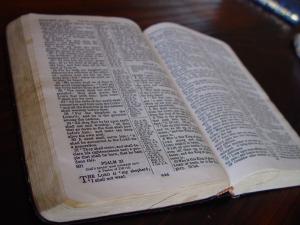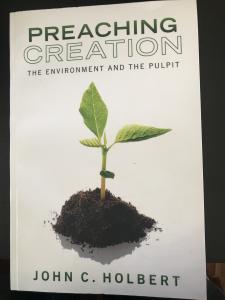(Lectionary for October 1, 2017)
On the surface of this well-known story, we find a typical miracle tale in which the harried Moses is confronted again by the nagging Israelite mob, demanding that he provide something for them in the blasted wilderness where he has led them. This time the problem is lack of water, an obvious and all-too- familiar issue in the midst of a desert. It is more than reasonable for the thirsting people to make this demand, for without water, all living things cannot live for long. But the request follows apattern that has already become well established among these escaping exiles: there is a lack, in this case no water; they demand water by “quarreling with Moses” (Ex.17:2); Moses accuses them of not really quarreling with him, but with “testing YHWH” (Ex.17:2); the people cry out with some hyperbolized idea of Moses’ real intentions for them, “Why did you bring us out of Egypt to kill us, our children, and our livestock with thirst;” Moses turns to YHWH in terror and frustration—“what shall I do with this people who are about ready to stone me”; YHWH responds with a miracle, asking Moses to strike a rock at Horeb from which water will gush forth. And so it does.
all living things cannot live for long. But the request follows apattern that has already become well established among these escaping exiles: there is a lack, in this case no water; they demand water by “quarreling with Moses” (Ex.17:2); Moses accuses them of not really quarreling with him, but with “testing YHWH” (Ex.17:2); the people cry out with some hyperbolized idea of Moses’ real intentions for them, “Why did you bring us out of Egypt to kill us, our children, and our livestock with thirst;” Moses turns to YHWH in terror and frustration—“what shall I do with this people who are about ready to stone me”; YHWH responds with a miracle, asking Moses to strike a rock at Horeb from which water will gush forth. And so it does.
A very similar pattern may be found earlier in the stories of Exodus: the tale of the gifts of manna and meat at Ex.16:1-30 and the great miracle at the Sea of Reeds in Ex.14:10-14. In all three of these texts, the grumbling Israelites are in the end satisfied by YHWH and YHWH’s chosen leader, Moses, but only after this interplay of demand, anger, and fear.
And something else strikes me as especially noteworthy. The Israelites are terribly slow learners! Even after the parting of the waters, and even after the astonishing appearance of manna and quail, when there is no water to hand to wash it all down with, they are still grumbling and complaining, still unconvinced about YHWH’s ability to provide. 17:7 makes that point crystal clear: “Is YHWH with us, or not?” they moan; no multiple and obvious acts of divine munificence seem able to satisfy their demanding so uls. One would imagine that parting waters, miraculous manna, and rocks gushing water might serve as signs that YHWH in reality cares for them uniquely and unrelentingly, but apparently not.
uls. One would imagine that parting waters, miraculous manna, and rocks gushing water might serve as signs that YHWH in reality cares for them uniquely and unrelentingly, but apparently not.
And this theme reappears radically in the New Testament Gospels, especially in the synoptic Matthew, Mark, and Luke. In all three of those, after the astonishing ministry of Jesus, after his appalling death, and his amazing resurrection and appearances to his disciples, there remain voiced doubts among them. In Mark, the three women rush from the empty tomb “in fear and terror and say nothing to anyone” (Mark 16:8). In Matthew, Jesus stands on a mountain a la Moses and calls the disciples to a world-wide mission, but even there we are told that “some doubted” (Mt.28:17). And in Luke, the two despondent disciples trudge the Emmaus road, thinking the Jesus event has been cut off by the monstrous crucifixion; this sad scene occurs after the women who witness the empty tomb are not believed by the men (Luke 24:11) and after Peter himself peers into that tomb and can only think to “go home” and be amazed (Luke 24:12)! I need hardly add the notorious “doubting Thomas” in John’s Gospel, who demands physical proof beyond what has eyes have seen and ears heard.
Thus the cry, “Is God with us or not” is quite obviously a basic human one, appearing as it does in prominent places in both biblical testaments. What then are we to make of all that? In what ways are we heirs of that anguished demand for proof? When we are fond of quoting Hebrews’ infamous definition of faith as “the conviction of things not seen,” why must we see before we can believe?
I find this a crucial idea in twenty-first century faith and lack thereof. For those who have decided against faith of any sort, among the so-called new atheists (though I doubt there is anything really new about them), the claim is that believers can finally show no physical proof of their beliefs, and hence for these atheists such belief is fatuous, foolish, and useless. I saw a recent bumper sticker that makes the point: “Religion, because thinking is hard.” The assumption is that anyone who embraces religion is by definition one who does no thinking. As a believer myself, I tend to take such a ridiculous statement quite personally. I imagine that over the fifty years of my ministry of teaching and preaching that I have done a good bit of thinking, not all of it sound, I readily admit, but a fair amount of it in fact hard. Writers like Richard Dawkins and Sam Harris, among many others, assault the straw man of fundamentalism, demonstrate its obvious weaknesses of logic, and then proceed to tar all belief with that broad and easily applied brush. I, too, readily find fundamentalism lacking in numerous ways not unlike these atheists, but my belief bears little resemblance to theirs.
And these very fundamentalists, and others who demand some sorts of scientific or historical proof of biblical events, resort to absurd mental gymnastics to show physically how Jesus in fact fed those five thousand with five loaves and two fish (the fish were tuna! All brought out their hidden lunches and shared them around!), or return ad naseum to the shroud of Turin to prove that the resurrection was an event of history, or search once more for Noah’s ark on Ararat, or reread the archaeological evidence to prove conclusively that the walls of Jericho did in fact tumble down and at the very time the text of Joshua said they did. “Is YHWH with us or not?” is a cry that must be answered by scientific or historical proof, whether one is atheist or fundamentalist. Is that reality not rife with irony? The fact that the Israelites fail to be convinced by walls of water, magic bread from the sky, and water rushing from a rock, suggests quite conclusively that historical and scientific evidence is not the test of faith. The stories demonstrate that no amount of physical proof can ever provide unshakeable faith for anyone.
 I contend that both atheists and fundamentalists are wrong about this. So much of the biblical record is at the last immune to scientific or historical research, primarily because the texts themselves were never to be seen in that light. The vast bulk of them are stories, plain and simple, or, better said, stories neither plain nor simple. These are stories by which one may find the life of God and may also find a life worth living with God. “Is YHWH with us or not?” is a question that all we believers ask, and that perhaps every day. In our better moments, we answer, “without doubt!” And in our moments of fear and heartache and pain, we say, “how we hope God is there!” No amount of traditional proof will give us the certainty that humans always crave. But steady attention to the tales the ancients told can help us in our uncertainties and can lead us to that conviction where things are not seen, but where things like rich story can work toward a living faith.
I contend that both atheists and fundamentalists are wrong about this. So much of the biblical record is at the last immune to scientific or historical research, primarily because the texts themselves were never to be seen in that light. The vast bulk of them are stories, plain and simple, or, better said, stories neither plain nor simple. These are stories by which one may find the life of God and may also find a life worth living with God. “Is YHWH with us or not?” is a question that all we believers ask, and that perhaps every day. In our better moments, we answer, “without doubt!” And in our moments of fear and heartache and pain, we say, “how we hope God is there!” No amount of traditional proof will give us the certainty that humans always crave. But steady attention to the tales the ancients told can help us in our uncertainties and can lead us to that conviction where things are not seen, but where things like rich story can work toward a living faith.
(Images from Wikimedia Commons)











